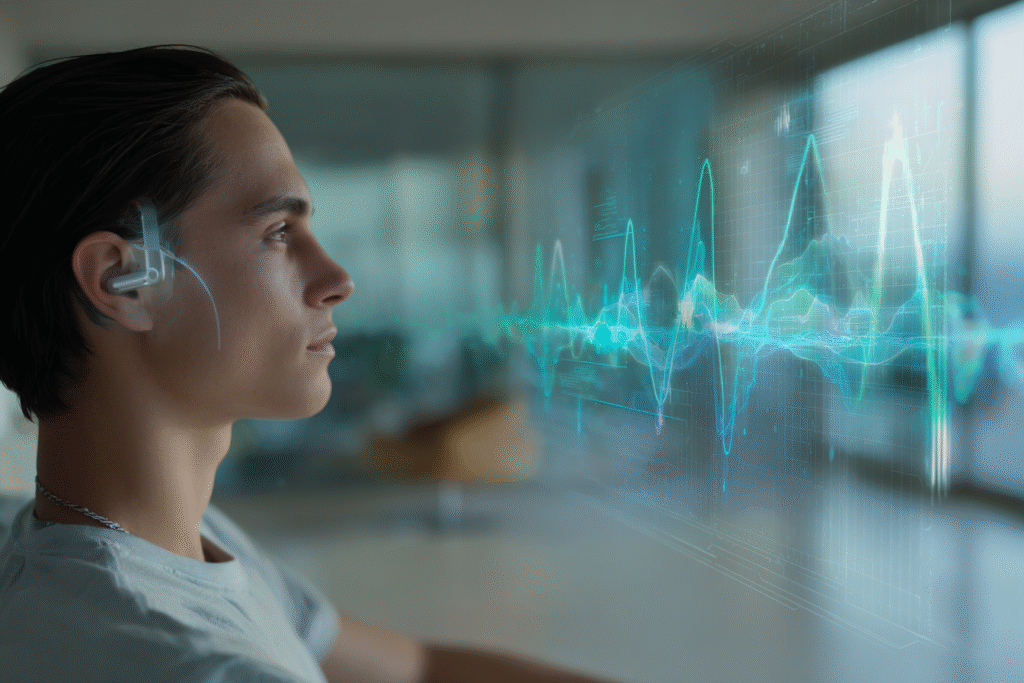The space between stimulus and response is where your power lives.
Note: This article is for educational and informational purposes only. See full disclaimer at the end.
Imagine catching yourself in the exact second before you say something you’ll regret — and being able to choose differently. That’s the power that lives in the space between stimulus and response. And now, technology can make that space so visible you could almost measure it with a ruler.
You can have real-time feedback on your emotional state, knowing exactly when stress begins to hijack your nervous system, and having tools that guide you back to balance before overwhelm takes hold. What once required years of meditation practice or therapeutic insight can now be measured, tracked, and optimized with precision.
We’re entering an era where emotional regulation isn’t just a skill we develop through trial and error—it’s becoming a science we can track, understand, and systematically improve. But here’s what most people miss: the technology is only as powerful as your understanding of the deeper principles it reveals.

Your Emotional Dashboard
Emotions aren’t just psychological experiences—they’re complex neurobiological events involving specific brain networks [1]. Research shows that emotion regulation involves the coordination between prefrontal control regions and limbic emotional centers, with the anterior cingulate cortex serving as a critical hub for this communication [2].
The breakthrough insight comes from understanding that emotions generate measurable physiological signatures before we’re consciously aware of them [3]. Your heart rate variability changes, your breathing patterns shift, your nervous system activation alters—all preceding the subjective experience of feeling stressed, anxious, or overwhelmed.
This is where heart rate variability (HRV) technology becomes transformative.
A comprehensive meta-analysis of 14 randomized controlled trials involving 794 participants found that HRV biofeedback produced significant improvements in depressive symptoms with a medium effect size [4].
HRV biofeedback works by training coherence between your heart rhythm patterns and your emotional state [5]. When you’re stressed, frustrated, or anxious, your heart rhythm patterns become erratic and chaotic.
When you’re in a positive emotional state—appreciation, calm, focus—your heart rhythms form smooth, sine-wave-like patterns.
Modern HRV devices like the HeartMath Inner Balance system provide real-time feedback on your heart rhythm coherence, teaching you to shift from chaotic to coherent patterns through focused breathing and positive emotion activation [6].
The technology measures your heart rhythm through a simple earlobe sensor and translates this data into immediate visual feedback.
Large-scale analyses confirm the pattern: positive emotions were consistently associated with higher coherence scores and more stable heart rhythm frequencies [6]. Conversely, negative emotions showed lower scores and more dispersed patterns, reflecting emotional strain [7].
The ability to detect and respond at this stage — before emotions fully surface — changes emotional regulation from a reactive skill into a proactive system.
Understanding these pre-conscious shifts is only half the battle. The real breakthrough comes when you can see them, respond in real time, and train your system to adapt — which is exactly what the TECH framework is designed to help you do.

The TECH Framework for Emotional Regulation
Based on the research and practical applications, here’s a systematic framework for using technology to enhance emotional regulation:
Track: Physiological Awareness
Use HRV monitoring to develop awareness of your baseline autonomic patterns [20]. Regular tracking reveals your individual patterns—when you’re most resilient, which activities or stressors consistently dysregulate your system, and how different interventions affect your physiology.
This allows you to spot the early signs of burnout before they steal your focus.
Engage: Real-Time Intervention
When you notice early signs of dysregulation through your monitoring device, engage specific techniques:
- Heart-focused breathing at your resonant frequency (typically 5-6 breaths per minute)
- Positive emotion activation through appreciation, gratitude, or compassion practices
- Progressive muscle relaxation guided by biofeedback indicators
This helps you shift from anxiety to calm in under two minutes.
Calibrate: Pattern Recognition
Modern emotional regulation apps provide pattern recognition capabilities, helping you identify triggers, optimal intervention times, and which techniques work best for your unique nervous system [21].
This allows you to predict emotional triggers and plan for them before they happen.
Habituate: Integration Training
Consistent practice with biofeedback technology creates lasting neuroplastic changes [15]. A 5-week study found that HRV biofeedback training increased coordination between emotional brain regions and enhanced functional connectivity in emotion-related networks.
Over time, this makes regulation your default mode, not just a rescue plan.
While HRV biofeedback works through the heart-brain connection, emerging neurostimulation technologies target the neural pathways of emotional regulation more directly.

The Neurobiology of Regulation
Transcutaneous vagus nerve stimulation (tVNS) represents another frontier in emotional regulation technology [8]. Research demonstrates that non-invasive vagal stimulation enhances cognitive emotion regulation, helping people better use reappraisal strategies when facing emotional challenges.
The vagus nerve serves as a communication highway between your brain and body, with afferent fibers carrying information from your organs to your brain and influencing areas crucial for emotional processing—the amygdala, insula, hippocampus, and prefrontal cortex [9].
Additional clinical research shows that tVNS can both reduce negative emotional intensity and enhance accuracy in recognizing certain emotional states [9][10][11].
The remarkable discovery is that vagal stimulation enhances recognition of certain emotions while attenuating others, essentially fine-tuning your emotional perception and regulation capabilities [11].
While tVNS works on the neural hardware of regulation, mindfulness-based approaches target the software — the patterns of attention and awareness that shape how we experience emotion.
Mindfulness Technology Integration
Beyond hardware-based interventions, combining mindfulness practices with biofeedback technology creates powerful, measurable gains in emotional regulation [12].
Neuroimaging studies show that mindfulness-based interventions produce measurable changes in brain regions involved in attention systems, emotion regulation, and self-referential processing.
What’s particularly interesting is that mindfulness appears to engage both top-down cognitive control mechanisms and bottom-up sensory awareness systems, creating a more comprehensive approach to emotional regulation than either technology or meditation alone [13].
Studies show that even brief mindfulness meditation protocols improve emotion processing, and when combined with physiological feedback, participants develop more sophisticated awareness of their internal states and greater capacity for regulation [14].
Research from the ReSource Project demonstrates that contemplative mental training enhances voluntary heart rate variability upregulation through biofeedback, suggesting that meditation practice and HRV technology create mutually reinforcing benefits [15].

Practical Implementation Strategies
Beginning Protocol
Start with 10-15 minutes of daily HRV coherence training using a validated device [23]. Research shows that even brief sessions can produce measurable improvements in emotional regulation capacity.
Advanced Integration
After establishing baseline proficiency, integrate real-time monitoring throughout your day [22]. Use brief coherence sessions during transitions, before challenging meetings, or when you notice stress accumulation.
Crisis Intervention
Develop protocols for acute stress situations [24]. Having a practiced routine with your technology allows you to quickly shift from reactive states to regulated responses even under pressure.
These daily and situational strategies become even more powerful when integrated with the larger models we’ve explored in this series.
Integration with Established Frameworks
This technological approach integrates naturally with the frameworks we’ve established throughout this series:
PEACE Framework Connection: Technology provides the “Personal Monitoring” component that enhances all other elements—you can track how different activities affect your emotional state and optimize your approach based on data rather than guesswork.
Timing Intelligence: HRV patterns reveal your optimal timing for different activities. When your coherence is high, you’re in an ideal state for challenging conversations, creative work, or decision-making.
Stress Architecture: Technology helps you distinguish between artificial stress (created by your interpretations) and real physiological stress responses, allowing more precise interventions.
The Future Is Human-Centered
Technology provides unprecedented insight into your emotional patterns, but it’s a bridge — not a destination. The most powerful outcome is when you can sense those shifts without any device and respond with precision [16][17].
As wearables become more sophisticated, AI learns to recognize individual emotional patterns, and neurostimulation devices become more precise, we’re moving toward truly personalized emotional regulation systems that adapt to your unique physiology and life circumstances [18][19].
These advances will make the technology more intuitive and effective, but the fundamental human skills of awareness and choice remain central.
But your wisdom, intuition, and lived practice remain the ultimate emotional regulation technology.
This is the personal layer of regulation — the skill of mastering your own state.

Practice, Practice, Practice
Your emotional regulation technology practice should complement, not replace, foundational wellness practices. Use the data and feedback to enhance your meditation, improve your stress management, and develop more sophisticated self-awareness.
The ultimate goal isn’t dependence on external devices—it’s developing such refined internal awareness and regulation skill that technology becomes an occasional optimization tool rather than a daily necessity.
Start with one tool. Track your patterns. Practice daily until regulation becomes second nature. Use your data to refine your personal playbook for stress and recovery. And remember — the most advanced emotional regulation system is still the one built into you.
The space between stimulus and response — that’s where your freedom lives.
Today, you can start measuring it. Tomorrow, you’ll be able to master it without the measurement.
See you in the next insight.
Comprehensive Medical Disclaimer: The insights, frameworks, and recommendations shared in this article are for educational and informational purposes only. They represent a synthesis of research, technology applications, and personal optimization strategies, not medical advice. Individual health needs vary significantly, and what works for one person may not be appropriate for another. Always consult with qualified healthcare professionals before making any significant changes to your lifestyle, nutrition, exercise routine, supplement regimen, or medical treatments. This content does not replace professional medical diagnosis, treatment, or care. If you have specific health concerns or conditions, seek guidance from licensed healthcare practitioners familiar with your individual circumstances.
References
The references below are organized by study type. Peer-reviewed research provides the primary evidence base, while systematic reviews synthesize findings.
Peer-Reviewed / Academic Sources
- [1] Etkin, A., Büchel, C., & Gross, J. J. (2015). The neural bases of emotion regulation. Nature Reviews Neuroscience, 16(11), 693-700. https://www.nature.com/articles/nrn4044
- [2] Zelazo, P. D., Qu, L., & Müller, U. (2016). The neuroscience of emotion regulation development: implications for education. PMC Article 5096655. https://pmc.ncbi.nlm.nih.gov/articles/PMC5096655/
- [3] Messina, I., et al. (2021). Neurobiological models of emotion regulation: a meta-analysis of neuroimaging studies of acceptance as an emotion regulation strategy. Social Cognitive and Affective Neuroscience, 16(3), 257-269. https://academic.oup.com/scan/article/16/3/257/6105256
- [4] Pizzoli, S. F. M., et al. (2021). A meta-analysis on heart rate variability biofeedback and depressive symptoms. Scientific Reports, 11, 6650. https://www.nature.com/articles/s41598-021-86149-7
- [5] de la Cruz, F., et al. (2021). The influence of heart rate variability biofeedback on cardiac regulation and functional brain connectivity. Frontiers in Neuroscience, 15, 691988. https://www.frontiersin.org/journals/neuroscience/articles/10.3389/fnins.2021.691988/full
- [6] McCraty, R., et al. (2025). Heart rate variability biofeedback in a global study of the most common coherence frequencies and the impact of emotional states. Scientific Reports, 15, 87729. https://www.nature.com/articles/s41598-025-87729-7
- [7] Vanderhasselt, M. A., et al. (2021). Non-invasive vagal nerve stimulation enhances cognitive emotion regulation. Behaviour Research and Therapy, 143, 103899. https://www.sciencedirect.com/science/article/abs/pii/S0005796721001327
- [8] Badran, B. W., et al. (2020). Application of noninvasive vagal nerve stimulation to stress-related psychiatric disorders. PMC Article 7563188. https://pmc.ncbi.nlm.nih.gov/articles/PMC7563188/
- [9] Koenig, J., et al. (2024). Transcutaneous vagus nerve stimulation improves emotional processing. Journal of Affective Disorders, 365, 196824. https://www.sciencedirect.com/science/article/pii/S0165032724019682
- [10] Steenbergen, L., et al. (2021). Recognizing emotions in bodies: Vagus nerve stimulation enhances recognition of anger while impairing sadness. Cognitive, Affective, & Behavioral Neuroscience, 21, 928-943. https://link.springer.com/article/10.3758/s13415-021-00928-3
- [11] Guendelman, S., et al. (2017). Mindfulness and emotion regulation: insights from neurobiological, psychological, and clinical studies. Frontiers in Psychology, 8, 220. https://www.frontiersin.org/journals/psychology/articles/10.3389/fpsyg.2017.00220/full
- [12] Hölzel, B. K., et al. (2017). Mindfulness and emotion regulation: insights from neurobiological, psychological, and clinical studies. PMC Article 5337506. https://pmc.ncbi.nlm.nih.gov/articles/PMC5337506/
- [13] Wu, R., et al. (2019). Brief mindfulness meditation improves emotion processing. Frontiers in Neuroscience, 13, 1074. https://www.frontiersin.org/journals/neuroscience/articles/10.3389/fnins.2019.01074/full
- [14] Lumma, A. L., et al. (2019). Voluntary upregulation of heart rate variability through biofeedback is improved by mental contemplative training. Scientific Reports, 9, 44201. https://www.nature.com/articles/s41598-019-44201-7
- [15] Bachman, S. L., et al. (2022). Increasing coordination and responsivity of emotion-related brain regions with a heart rate variability biofeedback randomized trial. Cognitive, Affective, & Behavioral Neuroscience, 22, 1032. https://link.springer.com/article/10.3758/s13415-022-01032-w
- [16] Garcia-Hernandez, R., et al. (2021). There is more to mindfulness than emotion regulation: a study on brain structural networks. Frontiers in Psychology, 12, 659403. https://www.frontiersin.org/journals/psychology/articles/10.3389/fpsyg.2021.659403/full
- [17] Herwig, U., et al. (2010). Mindfulness and emotion regulation—an fMRI study. PMC Article 4040090. https://pmc.ncbi.nlm.nih.gov/articles/PMC4040090/
- [18] Kumar, S., et al. (2024). Transcutaneous auricular vagus nerve stimulation to improve emotional state. PMC Article 10886536. https://pmc.ncbi.nlm.nih.gov/articles/PMC10886536/
Government / Institutional Sources
- [19] Tracey, K. J. (2024). Vagus nerve stimulation and mental health. Northwell Health Feinstein Institutes. https://feinstein.northwell.edu/news/insights/vagus-nerve-stimulation-and-mental-health
Industry / Technology Sources
- [20] HeartMath Institute (2025). The science of HeartMath. HeartMath.com. https://www.heartmath.com/science/
- [21] Quenza (2024). Revolutionize your therapy: discover the best emotional regulation apps. Quenza Blog. https://quenza.com/blog/emotional-regulation-apps/
- [22] Altini, M. (2021). 30 days of heart rate variability (HRV) biofeedback. Medium. https://medium.com/@altini_marco/30-days-of-heart-rate-variability-hrv-biofeedback-3fb7eb0209c3
- [23] HeartMath Institute (2025). Self-regulation technology. HeartMath Education. https://www.heartmath.org/education/emotion-self-regulation-technology/


